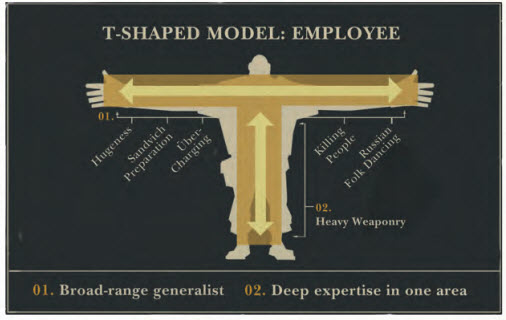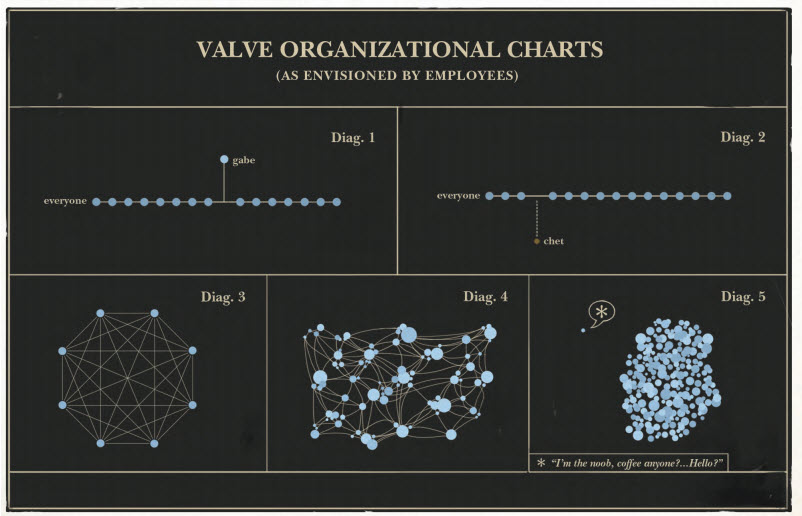5 Mind Blowing Concepts In Culture Banks Can Immediately Use
In the past (HERE), we highlighted how an employee handbook can have a colossal impact on culture that can radically alter your bank’s trajectory. We talked about how culture alone allowed Zingerman’s, a little Michigan deli, to have a worldwide following. We showed employee handbook examples from Netflix, Zappos and Nordstrom to demonstrate how their cultural tone can be leveraged into a strategic difference. However, there was one handbook that stood out not only for its style, but also for its extraordinary content. The employee handbook from Valve, a Washington gaming company, brings forth some management concepts that should make every bank take pause as they consider the following question – “What would my bank become if I did that?”
Lessons From Value
Valve is one of the most successful gaming companies in existence with such titles as Half-Life and Portal. Its revenue per employee has been among the highest in Silicon Valley and that includes Google, Facebook, and Apple. When the first line of your employee handbook is “A fearless adventure in knowing what to do when no one’s there is no one telling you what to do” you know the experience is going to be different. After reading some of these lessons, you might understand why.
“T-Shaped” People – While many banks hire to fill a particular functional role, Valve hires to fill a profile. Valve admits that they can always hire contract help to fill a role, but a quality employee, that is “stronger” than the average employee in the Valve group, always has a place in the organization if they are a good cultural fit and they have both a broad understanding of many functions (breadth) and deep expertise in one or more areas (depth). Hence, the “T” shape. Further, every employee hired must not only have the “T,” but must be “capable of literally running the company, because they will be.”

Hiring As A Discipline – “Hiring well is the most important thing in the universe. Nothing else comes close” is a sentence clearly stated in the Handbook. One of the most simple, yet profound acknowledgments that every bank should emulate is Valve’s realization and articulation that the skill of hiring people is a high agency discipline and should be the core competency of every area of the company. That is, if everyone develops the skill to hire, then everyone will understand the value of people and be responsible for the Company’s growth. Can your bank’s core competency not be loans or deposits, but hiring?
Welcome To Flatland – “Hierarchy is great for maintaining predictability and repeatability,” the Valve employee handbook postulates. However, while good for control, the traditional organizational structure doesn’t make sense for companies trying to make a difference. The handbook wonders out loud why it would go “out of its way to recruit the most intelligent, innovative, talented people on Earth” and then tell “them to sit at a desk” and follow instructions – this would only serve to “obliterate 99 percent of their value.”

To prevent this, Valve tells each employee that the company “is yours to steer” and has created a flat organizational structure where each employee functions within a group, but with no manager, no reporting structure, or no internal titles. Employees have complete control over what they work on, how they work, and for how long they work. If a group of employees wants to hire for a project, they are allowed to hire without clearance from management or human resources.
Basically, everything is a distributed process and every employee is responsible for their own development, performance reviews, management, recruiting, customer engagement, and every other task in the company. To succeed at this structure, Valve makes sure that every employee understands that they are both accountable and empowered. Plus, every process is transparent.
Fair Market Talent Organization – If your mind isn’t blown yet, consider the ramifications of the above. Employees are encouraged to network and go where their talent is best utilized and their heart is the most fulfilled. There are no physical barriers to keep everyone in one department together (e.g. loans, operations, finance, etc.), because there are no departments. People circulate freely. A task is put forth and it is up to the employees to self-organize. If an idea cannot attract the right talent, it dies or is morphed into a better idea that can. Conversely, if an employee is not attracted to any of the listed projects, then that is a clear sign that their talent may not be needed. While that sounds harsh, keep in mind that employees are free to start their own projects so many times and employees will feel that there is something grander to do and they have the authority to start their own team.
And yes, this means that, as an employee, you might end up doing work outside of your realm of expertise. If you think about it, by designing a better process, your bank could assure itself that every employee is challenged, is able to have a maximum impact on outcomes, and utilized to the maximum extent possible. What would that do to culture and productivity?
What If I Screw Up? – To quote Valve: “Nobody has ever been fired at Valve for making a mistake. It wouldn’t make sense for us to operate that way. Providing the freedom to fail is an important trait of the company— we couldn’t expect so much of individuals if we also penalized people for errors. Even expensive mistakes, or ones that result in a very public failure, are genuinely looked at as opportunities to learn. We can always repair the mistake or make up for it. Screwing up is a great way to find out that your assumptions were wrong or that your model of the world was a little bit off. As long as you update your model and move forward with a better picture, you’re doing it right.”
Well said, for sure. You tell your bank employees this and they will solve any problem you put in front of them.
Putting It Into Practice
Like a bee colony, Valve has created an organizational and employee experience that is self-learning, self-healing and always moving forward. Their process is their strength. If your bank has ever wanted to improve its culture, any one of these innovative management ideas would have an immediate impact on the organization and together they would create a powerful institution that would be unstoppable. If you want to read the entire handbook, check it out HERE.
Try it. Experiment with a small team and see if it works. In short, take a page from Valve and be fearless.

